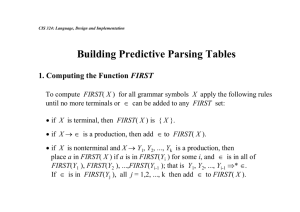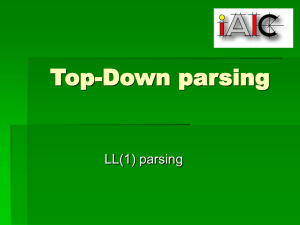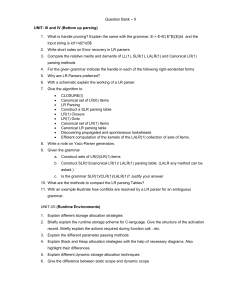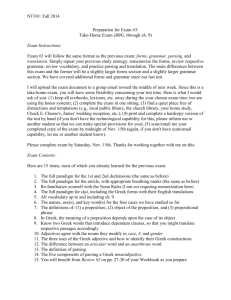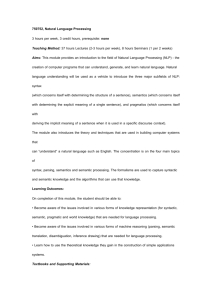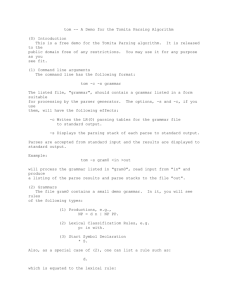LING/C SC 581: Advanced Computational Linguistics
advertisement
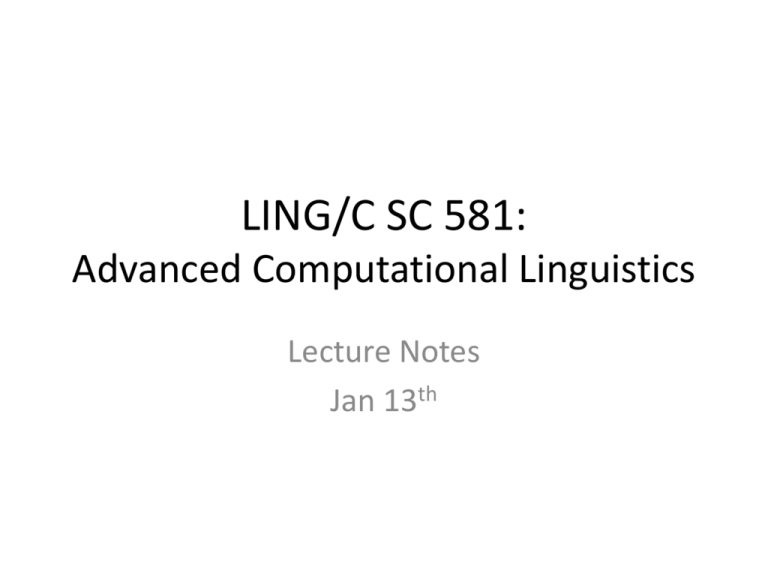
LING/C SC 581: Advanced Computational Linguistics Lecture Notes Jan 13th Course • Webpage for lecture slides and Panopto recordings: new server! – http://elmo.sbs.arizona.edu/~sandiway/ling581-16/ • Meeting information Course • Dates: no class on – Feb 10th: (out of town) – Mar 16th: Spring Break • Date: – May 4th: last day of classes = Wednesday Course Objectives • Follow-on course to LING/C SC/PSYC 438/538 Computational Linguistics: – continue with J&M: 25 chapters, a lot of material not covered in 438/538 • And gain more extensive experience – – – – – dealing with natural language software packages Installation, input data formatting operation project exercises useful “real-world” computational experience – abilities gained will be of value to employers Computational Facilities • Use your own laptop/desktop • Platforms Windows is maybe possible but you really should run some variant of Unix… – Linux (separate bootable partition or via virtualization software) • de facto standard for advanced/research software • https://www.virtualbox.org/ (free!) – Cygwin on Windows • http://www.cygwin.com/ • Linux-like environment for Windows making it possible to port software running on POSIX systems (such as Linux, BSD, and Unix systems) to Windows. – Mac OS X • Not quite Linux, some porting issues, especially with C programs, can use Virtual Box under OS X Grading • Completion of all homework tasks will result in a satisfactory grade (A) • Tasks should be completed before the next class. – Email me your work (sandiway@email.arizona.edu). – Also be prepared to come up and present your work (if called upon). Parsing methods (538) • From 538 (last semester), we covered a few different methods: – top-down, left-to-right Prolog default search strategy – problem: left recursion – solution: rewrite grammar into a non-left recursive grammar – solution: can keep left recursive parses Parsing methods (538) • CKY algorithm – rewrite grammar into Chomsky Normal Form (CNF) – binary branching syntax rules plus unary POS rules – use a 2D table – Example: 0 w1 1 w2 2 w3 3 (0..3 are position markers) w1 w2 w3 [0,1] [0,2] [0,3] [1,2] [1,3] [2,3] Bottom-Up Parsing • LR(0) parsing – An example of bottom-up tabular parsing – Similar to the top-down Earley algorithm described in the textbook in that it uses the idea of dotted rules – finite state automata revisited… Tabular Parsing • e.g. LR(k) (Knuth, 1960) – invented for efficient parsing of programming languages – disadvantage: a potentially huge number of states can be generated when the number of rules in the grammar is large – can be applied to natural languages (Tomita 1985) – build a Finite State Automaton (FSA) from the grammar rules, then add a stack • tables encode the grammar (FSA) – grammar rules are compiled – no longer interpret the grammar rules directly • Parser = Table + Push-down Stack – table entries contain instruction(s) that tell what to do at a given state … possibly factoring in lookahead – stack data structure deals with maintaining the history of computation and recursion Tabular Parsing • Shift-Reduce Parsing – example • LR(0) – left to right – bottom-up – (0) no lookahead (input word) • Three possible machine actions – Shift: read an input word » i.e. advance current input word pointer to the next word – Reduce: complete a nonterminal » i.e. complete parsing a grammar rule – Accept: complete the parse » i.e. start symbol (e.g. S) derives the terminal string Tabular Parsing • LR(0) Parsing – L(G) = LR(0) • i.e. the language generated by grammar G is LR(0) if there is a unique instruction per state deterministic! (or no instruction = error state) LR(0) is a proper subset of context-free languages – note • human language tends to be ambiguous • there are likely to be multiple or conflicting actions per state • if we are using Prolog, we can let Prolog’s computation rule handle it – via Prolog backtracking Tabular Parsing • Dotted rule notation – “dot” used to track the progress of a parse through a phrase structure rule – examples • vp --> v . np means we’ve seen v and predict np • np --> . d np means we’re predicting a d (followed by np) • vp --> vp pp. means we’ve completed a vp • state – a set of dotted rules encodes the state of the parse – set of dotted rules = name of the state • kernel • vp --> v . np • vp --> v . • completion (of predict NP) • np --> . d n • np --> . n • np --> . np cp Tabular Parsing • compute possible states by advancing the dot – example: – (Assume d is next in the input) • vp --> v . np • vp --> v . (eliminated) • np --> d . n • np --> . n (eliminated) • np --> . np cp Tabular Parsing • • Dotted rules – example • State 0: • s --> • np --> • np --> • np --> . np vp .d n .n .np pp – possible actions • shift d and go to new state • shift n and go to new state Creating new states shift d s --> . np vp np --> .d n np --> .n np --> .np pp np --> d. n shift n State 0 State 1 np --> n . State 2 Tabular Parsing • State 1: Shift N, goto State 3 State 3 np --> d n. shift n shift d s --> . np vp np --> .d n np --> .n np --> .np pp np --> d. n shift n State 0 State 1 np --> n . State 2 Tabular Parsing State 3 np --> d n. shift n • Shift – take input word, and – put it on the stack State 1 shift d np --> d. n s --> . np vp np --> .d n np --> .n np --> .np pp shift n State 0 np --> n . State 2 [[NDV man][ hit ] V…hit ] … ahit] []N… man][ V Input • state 3 (Powerpoint animation) Stack [N[Dman] a] [D a ] Tabular Parsing • State 2: Reduce action np --> n . State 3 np --> d n. shift n shift d s --> . np vp np --> .d n np --> .n np --> .np pp np --> d. n shift n State 0 State 1 np --> n . State 2 Tabular Parsing • Reduce NP -> N . – pop [N milk] off the stack, and – replace with [NP [N milk]] on stack [NP milk] [N milk] [V is ] … Input • State 2 Stack Tabular Parsing • State 3: Reduce np --> d n. State 3 np --> d n. shift n shift d s --> . np vp np --> .d n np --> .n np --> .np pp np --> d. n shift n State 0 State 1 np --> n . State 2 Tabular Parsing • Reduce NP -> D N . – pop [N man] and [D a] off the stack – replace with [NP[D a][N man]] [NP[D a ][N man]] [N man] [D a ] [V hit ] … Input • State 3 Stack Tabular Parsing • State 0: Transition NP State 3 np --> d n. shift n shift d s --> . np vp np --> .d n np --> .n np --> .np pp np --> d. n np shift n State 0 State 1 np --> n . State 2 s --> np . vp np --> np . pp vp --> . v np vp --> . v vp --> . vp pp pp --> . p np State 4 Tabular Parsing • for both states 2 and 3 – NP -> N . (reduce NP -> N) – NP -> D N . (reduce NP -> D N) • after Reduce NP operation – goto state 4 • notes: – states are unique – grammar is finite – procedure generating states must terminate since the number of possible dotted rules is finite – no left recursion problem (bottom-up means input driven) Tabular Parsing State Action Goto 0 1 2 Shift d Shift n Shift n Reduce np --> n 1 2 3 4 3 Reduce np --> d n 4 4 … … Tabular Parsing • Observations • table is sparse • example • State 0, Input: [V ..] • parse fails immediately • in a given state, input may be irrelevant • example • State 2 (there is no shift operation) • there may be action conflicts • example • State 1: shift D, shift N (only if word is ambiguous…) • more interesting cases • shift-reduce and reduce-reduce conflicts Tabular Parsing • finishing up – an extra initial rule is usually added to the grammar – SS --> S . $ • SS = start symbol • $ = end of sentence marker – input: • milk is good for you $ – accept action • discard $ from input • return element at the top of stack as the parse tree LR Parsing in Prolog • Recap – finite state machine technology + a stack • each state represents a set of dotted rules – Example – – – – s --> . np vp np --> .d n np --> .n np --> .np pp • we transition, i.e. move, from state to state by advancing the “dot” over the possible terminal and nonterminal symbols LR State Machine State 5 np np pp. State 13 ss s $. $ State 1 ss s .$ np s State 0 ss .s $ s .np vp np .np pp np .n np .d n State 4 s np .vp np np .pp vp .v np vp .v vp .vp pp pp .p np pp vp pp p State 6 pp p .np np .np pp np .n np .d n p v State 8 s np vp. vp vp .pp pp .p np p np State 11 pp p np. np np. pp pp .p np n n d State 3 np n. n d d State 2 np d .n n pp State 7 vp v .np vp v . np .np pp np .n np .d n State 12 np d n. p np State 9 vp vp pp. pp State 10 vp v np. np np. pp pp .p np [animation] Build Actions • two main actions – Shift • move a word from the input onto the stack • Example: – np --> .d n – Reduce • build a new constituent • Example: – np --> d n. Lookahead • LR(1) – a shift/reduce tabular parser – using one (terminal) lookahead symbol • decide on whether to take a reduce action depending on state x next input symbol • Example – select the valid reduce operation consulting the next word – cf. LR(0): select an action based on just the current state Lookahead • potential advantage – the input symbol may partition the action space – resulting in fewer conflicts • provided the current input symbol can help to choose between possible actions • potential disadvantages – larger finite state machine • more possible dotted rule/lookahead combinations than just dotted rule combinations – might not help much • depends on grammar – more complex (off-line) computation • building the LR machine gets more complicated Lookahead • formally – X --> α.Yβ, L • L = lookahead set • L = set of possible terminals that can follow X • α,β (possibly empty) strings of terminal/non-terminals • example – State 0 • ss-->.s $ • s-->.np vp • np-->.d n • np-->.n • np-->.np pp [[]] [$] [p,v] [p,v] [p,v] Lookahead • central idea • for propagating lookahead in state machine – if dotted rule is complete, – lookahead informs parser about what the next terminal symbol should be – example • NP --> D N. , L • reduce by NP rule provided current input symbol is in set L LR Parsing • in fact – LR-parsers are generally acknowledged to be the fastest parsers • especially when combined with the chart technique (table: dynamic programming) – reference • (Tomita, 1985) – textbook • • • • Earley’s algorithm uses chart but follows the dotted-rule configurations dynamically at parse-time instead of ahead of time (so slower than LR)
